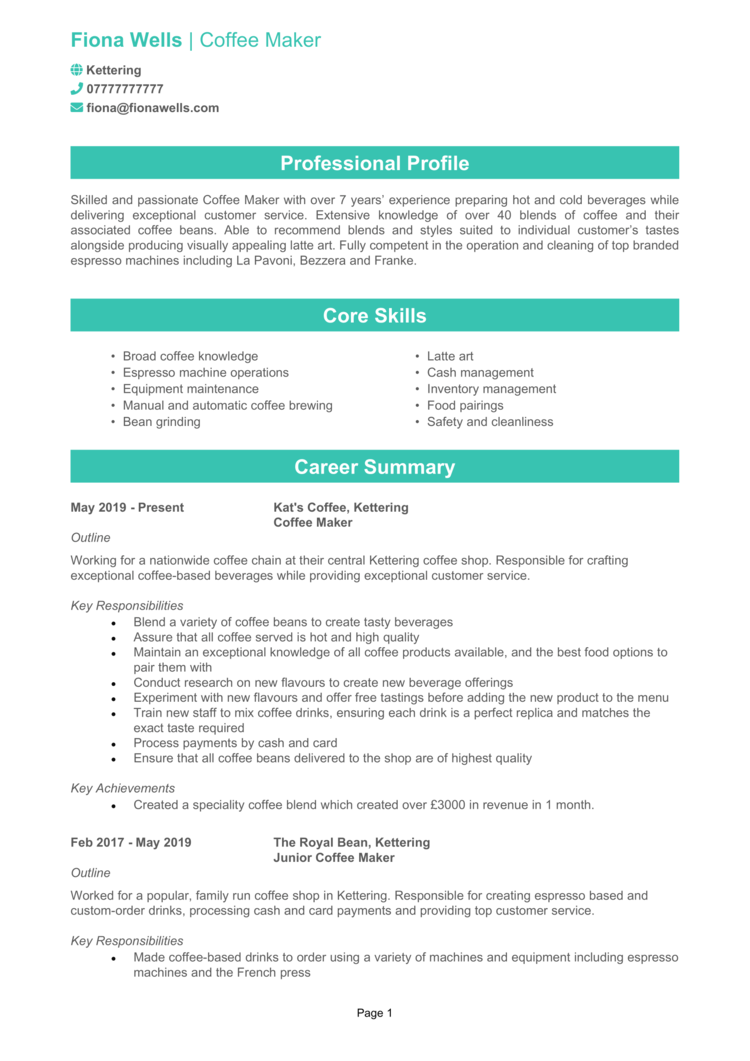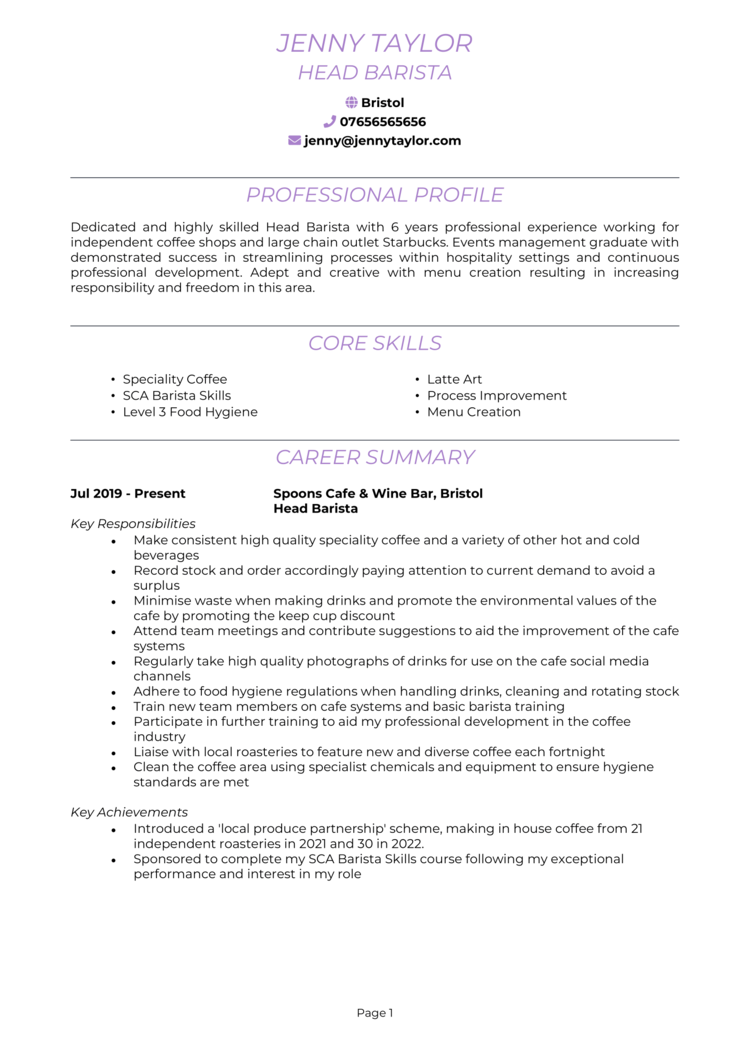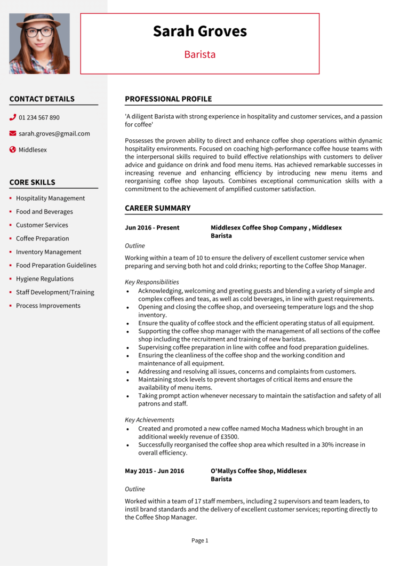As a barista, you’re the secret ingredient to ensuring a great customer experience.
Your CV leaves a lasting impression, just like coffee-making artistry and friendly service: it’ll need to be top quality to stand out in this competitive role.
This guide, complete with some Barista CV examples, will help you brew up a CV that proves you’re the cream of the crop and lands you the perfect café gig
Barista CV example

Coffee Maker CV example

Head Barista CV example

How to write your Barista CV
Learn how to create your own interview-winning Barista CV with this simple step-by-step guide.
This guide will take you through writing a Barista CV that highlights your beverage-making expertise and customer service strengths. By the end, you’ll have a CV that ensures you’re the top choice for any coffee-loving employer.
Barista CV structure


Your CV needs to be as inviting and well-structured as the café environment you create. Recruiters want to quickly see your ability to prepare top-quality beverages, maintain hygiene standards, and engage customers with warmth and efficiency, without needing to wade through an unnavigable mess of a CV.
Here’s how to structure your Barista CV:
- Name and contact details – Place these at the top for quick access. Adding a photo is completely optional.
- CV profile – Hook the reader with a concise summary of your coffee knowledge, customer focus, and reliability.
- Core skills – Briefly highlight your barista strengths, from espresso extraction to latte art and POS systems, with a small number of bullet points.
- Work experience – Detail your roles in reverse chronological order, emphasising responsibilities and achievements.
- Education – Show off academic qualifications like degrees, and certifications relevant to hospitality or food safety.
- Additional info – You’re also free to mention hobbies and interests, awards, or special training (like latte art courses).
Barista CV format


Your CV format should mirror the neatness and clarity you bring to your work behind the counter. Even with strong experience, poor formatting can obscure your talents, so keep it clean and consistent.
Formatting tips for a Barista CV:
- Bullet points – Use them to break down tasks and achievements into easy-to-scan details.
- Divide sections – Clear headings help recruiters navigate your CV’s layout to find key information quickly.
- Use a clear font and colour scheme – Opt for readability over flair: stick to crisp fonts that are easy to read.
- Keep it under 2 pages – Focus on your best qualities and most relevant experience without boring the recruiter with unnecessary detail.
Creating a strong Barista CV profile


Just like an espresso shot, your professional profile is here to deliver an immediate kick to the reader: summarise your coffee expertise, friendly demeanour, and punctual, efficient work habits with just a few lines. It should convince the recruiter to read on some more
Barista CV profile examples
Profile 1
Friendly Barista with three years of experience in fast-paced coffee shops, skilled in brewing specialty coffees, managing inventory, and delivering excellent customer service. Adept at using espresso machines and POS systems while maintaining a clean and organised workspace.
Profile 2
Reliable Barista with four years of experience in boutique cafes, focusing on crafting high-quality beverages and building rapport with regular customers. Skilled in latte art, menu recommendations, and ensuring compliance with food safety standards.
Profile 3
Efficient Barista with over six years of experience in high-volume chain coffee shops, specialising in speed and accuracy during busy periods. Experienced in training new team members, upselling menu items, and maintaining operational efficiency
What to include in your Barista CV profile
Make sure your profile is tailored to the role you’re after: but generally, it should include the following:
- Where you’ve worked – Mention the types of cafés, coffee shops, or restaurants you’ve staffed.
- Your top qualifications – Highlight barista training courses, food safety certificates, or hospitality diplomas.
- Essential coffee skills – Include espresso extraction, milk steaming, latte art, and understanding of coffee beans/origins.
- Customers you’ve served – Reference your experience catering to a diverse clientele, from busy commuters to weekend brunch crowds.
- Tools you’ve used – Mention familiarity with espresso machines, grinders, POS systems, and cleaning equipment.
- Special requests handled – If you’ve got experience handling things like vegan coffee or sugar-free syrup, mention your broad range of skills here.
Core skills section


Now for your CV’s cafe menu board: your core skills consist of clear categories, tempting options, and a quick way for recruiters to see what’s on offer.
It will show employers why you’re the barista who can keep customers coming back. Focus on practical coffee-making abilities and the interpersonal skills that make customers feel welcome.
Finding it tricky to craft a barista CV?
Give our CV builder a go! It serves up stylish templates, pre-written content, and expert guidance to help you create a strong application in minutes.
Top skills for your Barista CV
- Espresso Extraction – Pulling perfect shots with balanced flavour and crema.
- Milk Frothing and Latte Art – Crafting silky microfoam and simple latte art that wows customers.
- Customer Service – Greeting customers, remembering regulars’ orders, and maintaining a friendly rapport.
- POS System Operation – Swiftly processing transactions to keep queues moving.
- Hygiene and Food Safety – Following sanitary guidelines, ensuring clean surfaces and utensils.
- Time Management – Handling multiple orders simultaneously without sacrificing quality.
- Inventory Checks – Monitoring stock levels of beans, milk, syrups, and cups to avoid shortages.
- Menu Knowledge – Recommending drinks and snacks based on customers’ taste preferences.
Writing about your work experience


Your work experience is where you demonstrate how your coffee skills and customer focus translate into a great café atmosphere. Show your progression from simpler tasks to more complex responsibilities, and highlight moments where you improved service or efficiency.
List your roles in reverse chronological order. If you’re newer to the role, include volunteering, internships, or any related customer service experience that shows transferable skills.
What’s the correct way to structure job history on your CV?

- Outline – Briefly describe the café or coffee shop, your role, and the environment (high-volume commuter café, artisan coffee bar, etc.).
- Responsibilities – Highlight tasks like preparing drinks, maintaining cleanliness, or upselling baked goods. Use action verbs like “brewed,” “served,” or “recommended.”
- Achievements – Add measurable outcomes, such as reducing wait times, increasing sales of a particular product, or receiving positive feedback from customers.
Work experience samples for a Barista
Barista | Costa Coffee
Outline
Worked in a fast-paced coffee shop, preparing a variety of hot and cold beverages while providing exceptional service to customers. Ensured a welcoming environment and seamless operations during shifts.
Responsibilities
- Prepared espresso-based drinks, teas, and blended beverages to customer specifications.
- Operated and maintained espresso machines, grinders, and brewing equipment.
- Maintained cleanliness of the workspace, adhering to hygiene and food safety standards.
- Processed customer orders accurately using the POS system.
- Engaged with customers to provide recommendations and create a welcoming atmosphere.
Achievements
- Reduced wait times by 15% during peak hours through efficient workflow management.
- Received Employee of the Month recognition for outstanding customer service.
- Trained two new team members, improving team performance during busy periods.
Coffee Specialist | Esquire Coffee House
Outline
Provided high-quality coffee and customer service in a boutique café, focusing on creating personalised experiences for customers. Supported daily operations, including inventory management and team coordination.
Responsibilities
- Crafted speciality drinks, including latte art and seasonal beverages.
- Provided recommendations to customers, enhancing their overall experience.
- Monitored stock levels and restocked supplies as needed during shifts.
- Collaborated with team members to ensure smooth workflow and efficient service.
- Resolved customer complaints professionally, maintaining a positive reputation for the café.
Achievements
- Improved sales of speciality drinks by 20% through personalised recommendations.
- Achieved consistent 5-star customer reviews for exceptional service and drink quality.
- Introduced a new inventory system, reducing waste by 10%.
Barista | Starbucks
Outline
Worked as a Barista in a high-volume coffee chain, handling large crowds efficiently while maintaining high drink quality. Focused on teamwork and operational efficiency to meet customer demand.
Responsibilities
- Prepared high-quality drinks at speed during peak hours while maintaining accuracy.
- Adhered to company recipes and standards to ensure consistency across all beverages.
- Managed cash and card transactions accurately, balancing tills at the end of shifts.
- Trained new hires on drink preparation and customer service protocols.
- Ensured compliance with health and safety regulations, including food handling standards.
Achievements
- Increased order accuracy during rush periods, leading to a 15% reduction in customer complaints.
- Recognised by management for consistently meeting and exceeding daily sales targets.
- Improved team productivity by implementing more efficient workflow practices.
What’s the best way to write an education section?


The education section shows the training or qualifications that underpin your barista skills. It can be brief, focusing on any hospitality diplomas, food safety courses, or barista training programmes.
List qualifications in reverse chronological order. If you’re newer to the profession, emphasise courses or workshops that demonstrate your growth potential.
Best qualifications for Baristas
- City & Guilds Level 2 Barista Skills – Covers coffee preparation and equipment handling.
- Food Hygiene & Safety Level 2 Certificate – Ensures you meet hygiene standards.
- SCA (Specialty Coffee Association) Barista Skills Foundation – Demonstrates knowledge of coffee extraction and milk techniques.
- Hospitality NVQ or Diploma – Highlights broader hospitality and customer service training.
- First Aid at Work Certificate – Shows preparedness for handling minor emergencies.





